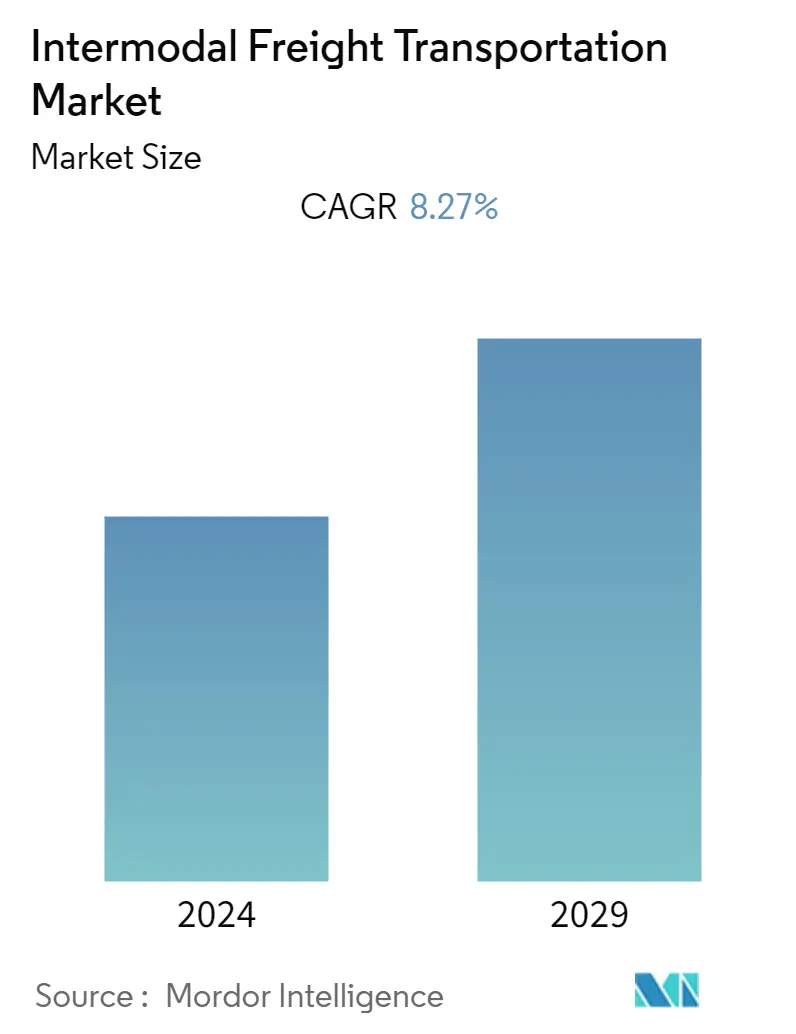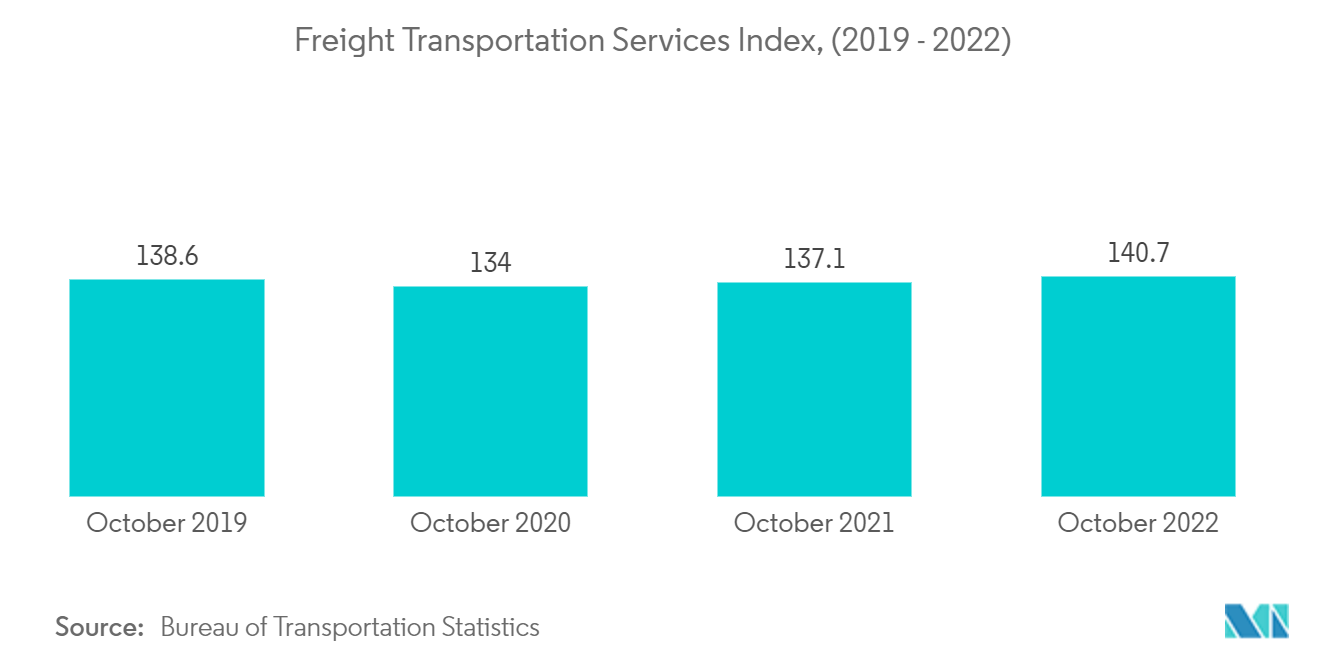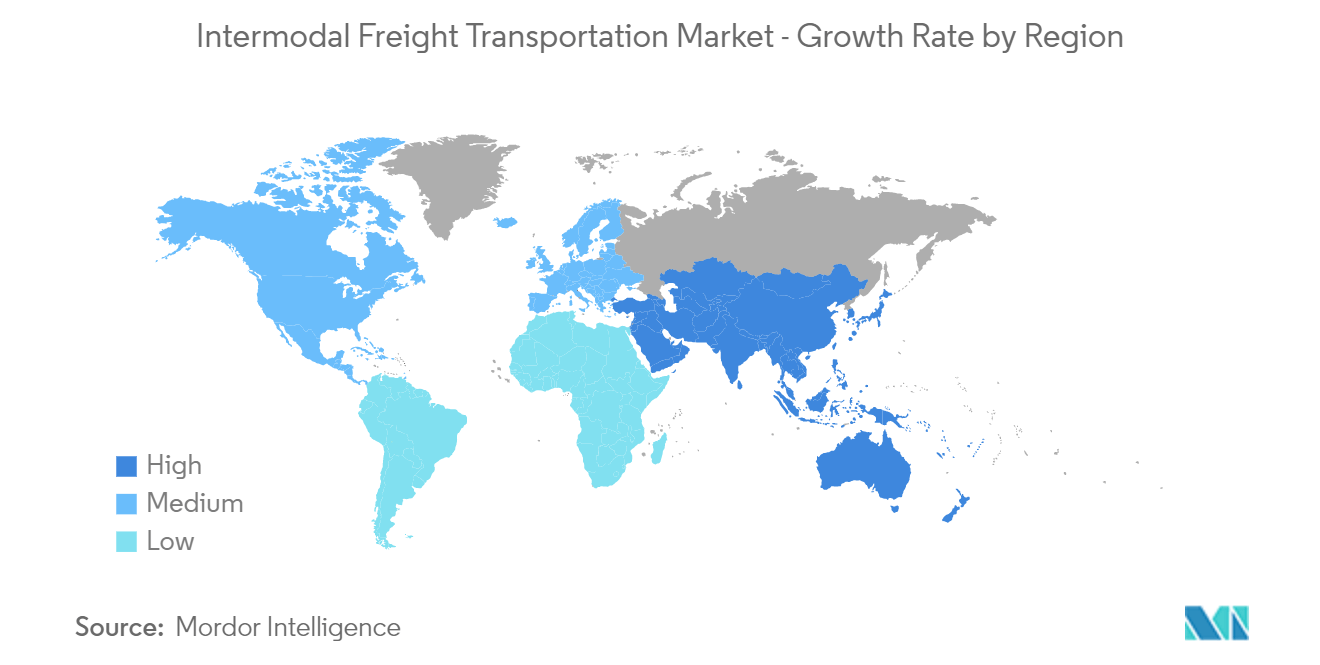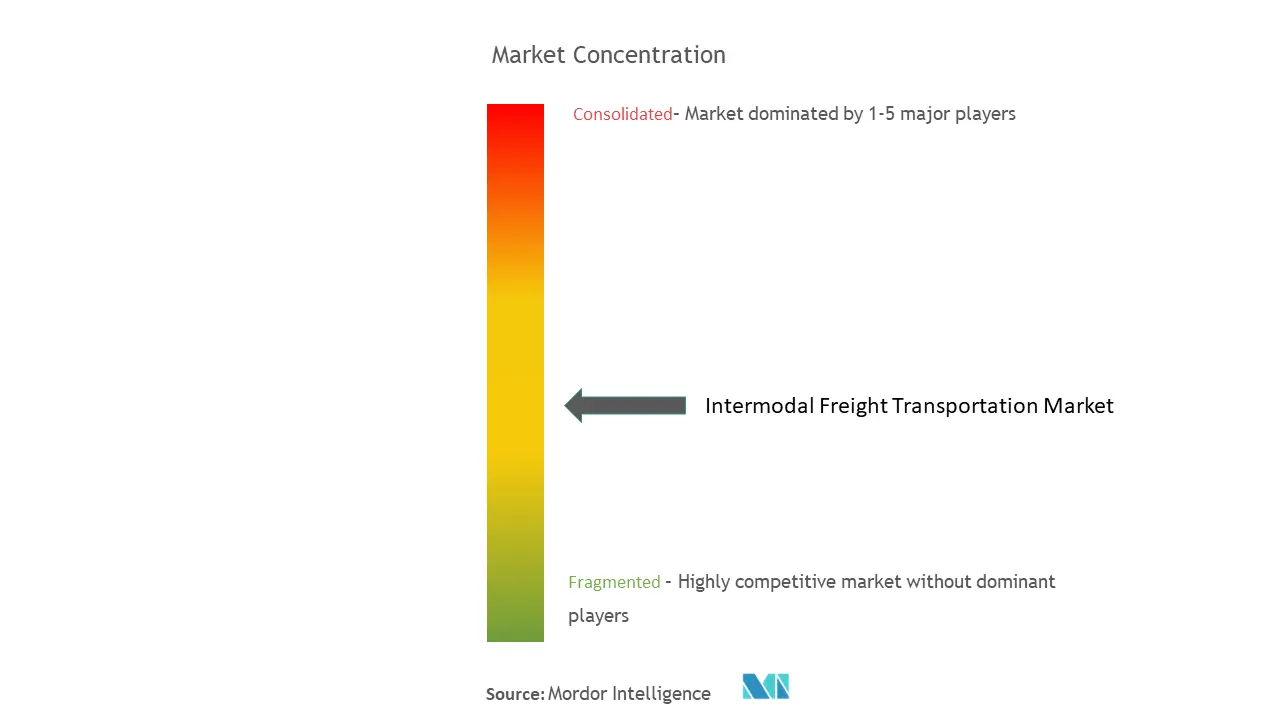Intermodal Freight Transportation Market Size

| Study Period | 2019 - 2029 |
| Base Year For Estimation | 2023 |
| CAGR | 8.27 % |
| Fastest Growing Market | Asia-Pacific |
| Largest Market | North America |
| Market Concentration | Medium |
Major Players
*Disclaimer: Major Players sorted in no particular order |
Intermodal Freight Transportation Market Analysis
Intermodal Freight Transportation Market is anticipated to register a CAGR of 8.27% during the forecast period. When moving long distances, companies should consider alternate transportation modes as they evaluate emerging ways to cut freight costs and their carbon footprint. Although trucking remains the most common means of domestic product shipment, intermodal freight transit offers freight savings and decreased emissions, particularly when delivering items over 500 miles or more. Intermodal can assist in reducing cargo handling, damage, and loss by optimizing each transport method's strengths and efficiency, allowing freight to be moved more safely and at a lower aggregate cost.
- Transportation accounts for 66% of overall logistics expenses, according to the Council of Supply Chain Management Professionals' State of Logistics Report. Management of the transportation network proactively may prevent these costs from rising as trucking issues such as driver shortages and productivity-stifling trucking rules limit capacity in the coming years. Intermodal may be a strong option if the company wants to reduce supply chain interruption, manage supply risk, and lower transportation expenses. Including multimodal transportation in the transportation mix results in significant cost reductions. By incorporating several means of transportation into the carrier base, the reliance on a single source of capacity is reduced. Supply chain leaders that use multimodal freight moves may gain in the short and long term by utilizing the capabilities of each mode of transportation.
- Moreover, the U.S. Environmental Protection Agency (EPA) reports that using intermodal transport for shipments over 1,000 miles can cut fuel use and greenhouse gas emissions by as much as 65% relative to truck transport alone. A truck that can transport 40,000 lbs from Los Angeles to Boston produces approximately 4.35 tons of carbon emissions. The same 40,000 pounds, which could be shipped via intermodal rail, produces 1.75 tons of carbon emissions, significantly less. Intermodal transportation can effectively help reduce a company's carbon footprint. The EPA estimates that every ton-mile of freight moved by rail instead of highway can reduce greenhouse emissions by two-thirds. This is essential as companies continually work to reduce their carbon footprint to comply with environmental regulations and meet their corporate sustainability goals.
- Extensive intermodal rail facilities are challenged by high truck volume and often serve the trucks in the order they arrive at a crane, which is not optimal. Efficiencies can be gained by calling the trucks to the crane to match the containers' stacking order rather than shuffling boxes to serve the trucks on a first-come, first-served basis. This makes the trucker with transactions significantly reduce the need to contact the terminal, helping terminals capture billable processes and events. Items such as checking whether a waybill is in place well before a trucker's arrival at the gate could be managed with the help of a mobile software application. This capability could help drivers perform advanced check-in and check-out, complete service requests, confirm unit locations, and receive parking location updates from a mobile phone.
- During the COVID-19 pandemic, the government globally restricted its borders to non-citizens and non-residents or imposed on those entering extended periods of self-isolation to limit the spread of the virus while implementing lockdowns, strict social distancing, and contact tracing measures. These often-excessive restrictions to cross-border and transit freight transport further aggravated the economic and social impacts of the pandemic shock on the global economy.
- The market is witnessing significant mergers and acquisitions by multiple companies to increase its presence. In June last year, Generix Group, a global provider of collaborative SaaS Software solutions for the Supply Chain, industrial, and retail ecosystems, assisted Jacquet Brossard, a Limagrain Group company and a major player in the food industry, in the transformation of its transport and supply operations through the SaaS implementation of Generix TMS and GCR (Generix Collaborative Replenishment) solutions.
Intermodal Freight Transportation Market Trends
This section covers the major market trends shaping the Intermodal Freight Transportation Market according to our research experts:
Rail and Road Transport is Expected to Hold Significant Share
- Intermodal transportation offers dependable freight shipment at a reasonable cost and might be incorporated into the current freight transportation infrastructure. The rail industry in the United States transports over 40 tons of freight per capita, and intermodal shipments are often made in 53-foot-long containers. According to CSX, one intermodal train can transport the same amount of freight as 280 trucks. Shippers examine various issues when deciding whether to use intermodal transportation, including the inefficiencies associated with railroad conversions to precision planned railroading (PSR), the availability of shipping equipment, load price, and the ongoing truck driver shortage.
- While the demand for more efficient and rapid goods shipping has risen, the rail industry has strived to enhance operations using precision-planned railroading. PSR refers to transporting the same amount of freight with fewer railcars and locomotives along a planned direct line over a rail network. Conventional trains move freight when full, but under PSR, trains start moving at a specified time regardless of whether or not the freight is there. PSR aims to enable faster speeds, longer trains, and shorter terminal dwell times. However, as the rail industry has moved to PSR, it has impacted existing shipping lanes and decreased equipment and staff.
- Railway operators in the United States and neighboring countries have strived to enhance equipment, shipping schedules, loading and unloading times, and the number of lanes to handle numerous delivery locations. The intermodal rail system in the United States stretches across the country, connecting every major port and providing some coast-to-coast service faster than the truck.Mexico has an outstanding rail infrastructure covering most of the country, with well-established rail connections near the US border. Canada has two main coast-to-coast railroads: the Canadian National Railway (CN) and the Canadian Pacific Railway (CPR).
- Technology and intermodal rail support shippers in meeting the transportation environment's difficulties. CSX Transportation has a network of more than 40 terminals. The intermodal business serves major markets east of the Mississippi and the transportation of products in numerous containers, providing corporations with service similar to trucking for shipments traveling more than 500 miles. CSX CSX Transportation surveyed transportation management system suppliers to get insight into intermodal rail transportation. Intermodal railways are more concerned with capacity and cost reductions. Adding a transportation management system, starting a multimodal conversion path, or ensuring the best use of both can help shippers achieve their goals.

North America is Expected to Hold Significant Share
- The intermodal freight transportation market in the North American region is increasingly dependent on the consumer economy's demand. The regional rail industry is concentrating on creating new intermodal services that can successfully rival over-the-road options. In February last year, Mullen Group Ltd. announced that its wholly owned subsidiaries, APPS Cartage Inc. and APPS Cargo Terminals Inc., had signed an agreement with CN to continue supplying intermodal services to APPS Transport for a period of time.
- According to IANA, overall intermodal volume will be 17.716,445 in 2022, a 3.9% decrease from 2021.Trailers dropped by 23.8% to 924,259, while domestic container volume increased by 1.6% to 8,147,044 units. Domestic equipment as a whole declined by 1.8% to 9,071,303.
The region is also witnessing significant new players entering the market. For instance, in November last year, RunBuggy OMI Inc., a digital platform that connects car shippers and transporters, announced the availability of its Hitch Transportation Management Solution (TMS). The cloud-based solution enables car shippers to seamlessly integrate and connect with their current transportation assets, whether through partners or in-house, and expand their transportation capacity with access to RunBuggy's Marketplace, a nationwide network of 17,000 verified drivers.

Intermodal Freight Transportation Industry Overview
The intermodal freight transportation market is moderately fragmented, as a few players are entering the market to provide various software and services related to supporting intermodal transportation methods. Moreover, acquisitions have been a key trend in the market over the years. Some of the key players include Oracle Corporation, Cognizant Technology Solutions Corp., HighJump (Körber AG), Blue Yonder Group, Inc. (JDA Software), etc.
In April 2022, to further diversify, LTG Cargo, the freight division of the Lietuvos Gelezinkeliai (LTG) company, introduced intermodal freight services to Duisburg, Germany. Customers will have rail access to one of Europe's most vital industrial clusters and the inland waterway port.
Intermodal Freight Transportation Market Leaders
-
Oracle Corporation
-
Cognizant Technology Solutions Corp,
-
Blue Yonder Group, Inc. (JDA Software)
-
HighJump (Körber AG)
-
Transplace, Inc.
*Disclaimer: Major Players sorted in no particular order

Intermodal Freight Transportation Market News
- December 2022: Aware Super introduced the intermodal terminals investment platform and targeted the national supply chain stalemate. Aware Super launched a new investment platform aimed at acquiring, constructing, operating, and managing an independent network of intermodal ports as the fund's latest plan to pursue and explore new sources of long-term returns for its infrastructure portfolio.
- June 2022: The Ningxia Hui Autonomous Region in Northwest China launched the first sea-rail intermodal freight train to Iran, establishing a new international logistics channel across the Caspian Sea. The new line, along with existing China-Europe freight rail routes, will assist in building a global transportation network that incorporates marine, rail, and road transport.
Intermodal Freight Transportation Market Report - Table of Contents
1. INTRODUCTION
- 1.1 Study Assumptions and Market Definition
- 1.2 Scope of the Study
2. RESEARCH METHODOLOGY
3. EXECUTIVE SUMMARY
4. MARKET INSIGHTS
- 4.1 Market Overview
-
4.2 Industry Attractiveness - Porter's Five Forces Analysis
- 4.2.1 Threat of New Entrants
- 4.2.2 Bargaining Power of Buyers/Consumers
- 4.2.3 Bargaining Power of Suppliers
- 4.2.4 Threat of Substitute Products
- 4.2.5 Intensity of Competitive Rivalry
- 4.3 Assessment on the impact due to COVID-19
5. MARKET DYNAMICS
-
5.1 Market Drivers
- 5.1.1 Increasing need for effective and cost-efficient means of transportation by global supply chains
- 5.1.2 Rising awareness regarding the reduction of carbon footprint
-
5.2 Market Challanges
- 5.2.1 Lack of effective effective planning and communication can increase transportation costs
6. MARKET SEGMENTATION
-
6.1 By Component
- 6.1.1 Software
- 6.1.2 Service
-
6.2 By Transportation Mode
- 6.2.1 Rail and Road Transport
- 6.2.2 Air and Road Transport
- 6.2.3 Maritime and Road Transport
- 6.2.4 Other Transportation Modes
-
6.3 End-User Industry
- 6.3.1 Industrial and Manufacturing
- 6.3.2 Oil and Gas
- 6.3.3 Consumer and Retail
- 6.3.4 Food & Beverage
- 6.3.5 Construction
- 6.3.6 Other End-User Industries
-
6.4 Geography
- 6.4.1 North America
- 6.4.2 Europe
- 6.4.3 Asia-Pacific
- 6.4.4 Latin America
- 6.4.5 Middle East and Africa
7. COMPETITIVE LANDSCAPE
-
7.1 Company Profiles*
- 7.1.1 Oracle Corporation
- 7.1.2 Cognizant Technology Solutions Corp
- 7.1.3 HighJump (Körber AG)
- 7.1.4 Blue Yonder Group, Inc. (JDA Software)
- 7.1.5 Transplace, Inc.
- 7.1.6 GE Transportation (Wabtec Corporation)
- 7.1.7 The Descartes Systems Group Inc. (Descartes Aljex)
- 7.1.8 Motorola Solutions, Inc.
- 7.1.9 Elemica, Inc. (Eyefreight BV)
- 7.1.10 Envase Technologies
8. INVESTMENT ANALYSIS
9. FUTURE OF THE MARKET
** Subject To AvailablityIntermodal Freight Transportation Industry Segmentation
Intermodal freight transportation is the process whereby multiple modes of transportation partner to provide integrated services. Intermodal is the use of two freight methods, such as truck and rail, to transport goods from the shipper to the consignee. The intermodal process usually begins with a container being moved by truck to a rail and then back to a truck to complete it.
The market sizes and forecasts are provided in terms of value (USD million) for all the above segments.
| By Component | Software |
| Service | |
| By Transportation Mode | Rail and Road Transport |
| Air and Road Transport | |
| Maritime and Road Transport | |
| Other Transportation Modes | |
| End-User Industry | Industrial and Manufacturing |
| Oil and Gas | |
| Consumer and Retail | |
| Food & Beverage | |
| Construction | |
| Other End-User Industries | |
| Geography | North America |
| Europe | |
| Asia-Pacific | |
| Latin America | |
| Middle East and Africa |
Intermodal Freight Transportation Market Research FAQs
What is the current Intermodal Freight Transportation Market size?
The Intermodal Freight Transportation Market is projected to register a CAGR of 8.27% during the forecast period (2024-2029)
Who are the key players in Intermodal Freight Transportation Market?
Oracle Corporation, Cognizant Technology Solutions Corp,, Blue Yonder Group, Inc. (JDA Software), HighJump (Körber AG) and Transplace, Inc. are the major companies operating in the Intermodal Freight Transportation Market.
Which is the fastest growing region in Intermodal Freight Transportation Market?
Asia-Pacific is estimated to grow at the highest CAGR over the forecast period (2024-2029).
Which region has the biggest share in Intermodal Freight Transportation Market?
In 2024, the North America accounts for the largest market share in Intermodal Freight Transportation Market.
What years does this Intermodal Freight Transportation Market cover?
The report covers the Intermodal Freight Transportation Market historical market size for years: 2019, 2020, 2021, 2022 and 2023. The report also forecasts the Intermodal Freight Transportation Market size for years: 2024, 2025, 2026, 2027, 2028 and 2029.
Intermodal Freight Transportation Industry Report
Statistics for the 2024 Intermodal Freight Transportation market share, size and revenue growth rate, created by Mordor Intelligence™ Industry Reports. Intermodal Freight Transportation analysis includes a market forecast outlook 2029 and historical overview. Get a sample of this industry analysis as a free report PDF download.



